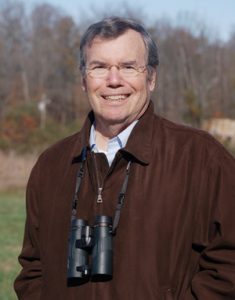Environmentalists and Roe v. Wade?
The Pulse and Politics of the Environment, Peace, and Justice
Bob Musil, President, Rachel Carson Council
“In nature nothing exists alone.”
“The aim of science is to discover and illuminate truth. And that, I take it, is the aim of literature, whether biography or history… It seems to me, then, that there can be no separate literature of science.”
“If the Bill of Rights contains no guarantee that a citizen shall be secure against lethal poisons distributed either by private individuals or by public officials, it is surely only because our forefathers, despite their considerable wisdom and foresight, could conceive of no such problem.”
— Rachel Carson
The revelation that the Supreme Court is likely to overturn Roe v. Wade brought me back to the 1990s in the Valley Medical Center in Brownsville, Texas on the U.S.-Mexico border. Dr. Carmen Rocco, a brilliant, caring, and lively young pediatrician, was showing me pictures and explaining the rise in cases of anencephaly, a birth defect that produces babies born with an opening in the skull with the brain outside it.
 The women who suffered this tragedy came from both sides of the border, including those from Matamoros who worked in maquiladoras, surrounded by air and water pollution, and poverty. Over the course of eight years, I learned all along the border the intimate connections between poverty, pollution, race, gender, a lack of even rudimentary medical care, let alone reproductive rights, and yes, climate change and population. The border is lined with small factories, refineries, smelters, barrios without clean drinking water, or even septic tanks. Environmentalists have done much to fight for clean air and water, to reduce emissions from factories, to ban or reduce some toxic chemicals. They have increased their understanding and work on environmental justice, the connection between poverty, pollution and people of color. A few have even spoken out against growing threats to democracy.
The women who suffered this tragedy came from both sides of the border, including those from Matamoros who worked in maquiladoras, surrounded by air and water pollution, and poverty. Over the course of eight years, I learned all along the border the intimate connections between poverty, pollution, race, gender, a lack of even rudimentary medical care, let alone reproductive rights, and yes, climate change and population. The border is lined with small factories, refineries, smelters, barrios without clean drinking water, or even septic tanks. Environmentalists have done much to fight for clean air and water, to reduce emissions from factories, to ban or reduce some toxic chemicals. They have increased their understanding and work on environmental justice, the connection between poverty, pollution and people of color. A few have even spoken out against growing threats to democracy.
But on the right to family planning and safe and accessible abortion? Population stabilization? Mostly silence. When Politico leaked the draft ruling on Roe v. Wade from Justice Samuel Alito, the media coverage was intense. But stories on how an end to reproductive rights and abortion would affect poor women living in pollution hotspots? Only reporters Eve Andrews and Naveena Sadasivam offered an in-depth feature in the on-line magazine Grist about poor Black women in Baytown, Texas.
 Baytown is an area that features an ExxonMobil refinery, a leaky Superfund site, and petrochemical facilities that routinely emit “chemicals like benzene, toluene, and xylene that cause developmental and reproductive issues in human bodies,” according to Nallelli Hidalgo of the Texas Environmental Justice Advocacy Services. The rates of maternal morbidity, or poor outcomes in labor and delivery, is 2.1 times higher for non-Hispanic Black women across Texas. Texas, is one of thirteen states that have “trigger” laws that will automatically ban abortion when Roe v. Wade is overturned. And twenty-five states set to ban abortions are mostly in the South and Gulf Coast with histories of discrimination and poor access to health care.
Baytown is an area that features an ExxonMobil refinery, a leaky Superfund site, and petrochemical facilities that routinely emit “chemicals like benzene, toluene, and xylene that cause developmental and reproductive issues in human bodies,” according to Nallelli Hidalgo of the Texas Environmental Justice Advocacy Services. The rates of maternal morbidity, or poor outcomes in labor and delivery, is 2.1 times higher for non-Hispanic Black women across Texas. Texas, is one of thirteen states that have “trigger” laws that will automatically ban abortion when Roe v. Wade is overturned. And twenty-five states set to ban abortions are mostly in the South and Gulf Coast with histories of discrimination and poor access to health care.
And what about the effects of an end to reproductive rights on climate change and population? An increase in population, wherever it occurs, increases carbon emissions from us humans, whether we are affluent or not. Of course, the bulk of emissions has come from wealthy industrialized nations like the U.S. But today even developing nations seek greater material prosperity, and nations like China, India, or Brazil have joined the ranks of major emitters. Again, family planning and full reproductive rights, with a goal of population stabilization, are as critical to fighting climate change and pollution as campaigns to reduce emissions from cars, trucks, factories, and electricity production. Years ago, I wrote that, “given the available data, two-thirds of the rise [of global emissions from carbon dioxide] from 1990 to 2003, for example, can be attributed to growth in human population alone. Anquing Shi of the World Bank has calculated that population growth, using mid-range estimates, will account for 48.3 percent of the projected increases in carbon emissions from 1990 to 2025. That’s an extra 3.73 billion tons of carbon.” To add some punch to the connection between family planning and climate change, I added the catchy phrase, “Condoms Capture Carbon.” At the time, I thought it would stick. It hasn’t.
In the aftermath of Justice Alito’s stunningly medieval judicial reasoning, I saw only one mention of abortion or population connected to the assault on Roe v. Wade. My friend, John Seager, CEO of Population Connection, concerned with climate change, as well as reproductive rights, wrote in the Population Connection magazine, “It pains me that most leading voices on climate adamantly refuse to mention the vital connections between population growth and climate change.” Seager went on to explain that “Peer-reviewed research finds that we can get 37 to 41 percent of needed emissions reductions by moving toward population stabilization. Many of those at risk around the world as the climate crisis deepens are women and girls in less developed nations.”
We live in a time of converging crises – democracy, the climate, the need for racial justice and the elimination of poverty, the loss of species, aggressive warfare and the threat of nuclear weapons, continued population growth, and the denial of the fundament human rights of women to reproductive freedom, health, care, education, and safety from assaults. We know, and have known, that these issues are inseparable. We cannot work or write or advocate against climate change alone, or only for women’s rights, or just to protect democracy. Environmentalists, and especially their large, well-funded organizations must no longer whisper the words abortion and population behind closed doors. The end of Roe v. Wade is a wake up call for all Americans to mobilize, speak out, and fight together.
 — Bob Musil is the President & CEO of the Rachel Carson Council and author of Rachel Carson and Her Sisters: Extraordinary Women Who Have Shaped America’s Environment (Rutgers, 2016) and Washington in Spring: A Nature Journal for a Changing Capital (Bartleby, 2016). He is also the editor of the forthcoming annotated edition from Rutgers University Press of Rachel Carson’s Under the Sea-Wind with his Introduction, updated marine science, and historic and contemporary illustrations and photographs.
— Bob Musil is the President & CEO of the Rachel Carson Council and author of Rachel Carson and Her Sisters: Extraordinary Women Who Have Shaped America’s Environment (Rutgers, 2016) and Washington in Spring: A Nature Journal for a Changing Capital (Bartleby, 2016). He is also the editor of the forthcoming annotated edition from Rutgers University Press of Rachel Carson’s Under the Sea-Wind with his Introduction, updated marine science, and historic and contemporary illustrations and photographs.






